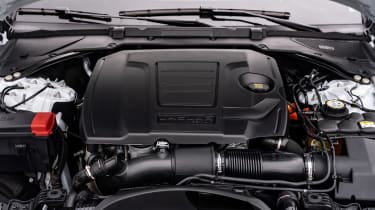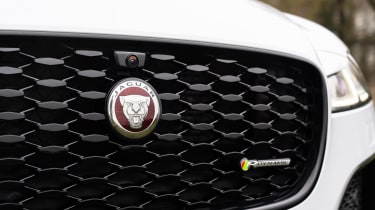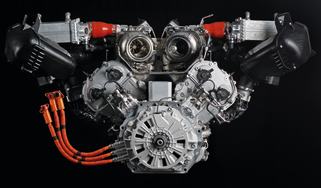Jaguar XF review – engine, gearbox and technical highlights
This is where the XF’s biggest weaknesses persist. Both Ingenium units are average at best
Six- and eight-cylinder engines were once commonplace in cars of this size, but now four-cylinders are the norm and anything more a real luxury. Unfortunately, it's a luxury the XF doesn't currently afford customers, with only two four-cylinder engine options in a total of three power outputs between them.
The engine is Jaguar Land Rover's Ingenium unit in both petrol and diesel iterations. This range starts at with a 200bhp 2-litre diesel and climbs up to a 296bhp 2-litre petrol, with a 247bhp petrol variant between.
> Limited-run Jaguar F-type Reims Edition revealed
The 2-litre diesel is now equipped with a very subtle mild-hybrid system, which helps achieve a peak torque of 317lb ft available between 1750-2500rpm. Petrol models are available in two forms, the P250 with 247bhp at 5500rpm and 269lb ft at 1200rpm, and a P300 producing 296bhp and 295lb ft, those outputs appearing at 5500rpm and 1500rpm respectively. These petrol models lack the diesel’s mild-hybrid system.
The diesel is available with both rear- and all-wheel drive, while the petrols are split P250 RWD and P300 AWD. The system itself is an electromechanical one that’ll only send a portion of the power to the front wheels, keeping the XF AWD resolutely rear-biased.
All models are fitted with an 8-speed torque-converter automatic, and while smooth, responsiveness is not very high on the agenda. When fitted to either petrol, the relatively thin torque figures require the transmission to shuffle ratios more often than is ideal, highlighting the muddled nature of the gear changes. Left to its own devices and kept to a gentle pace, the transmission is just about benign enough to slink into the background, but try to make progress and the ‘box quickly reveals its shortcomings.
The diesel’s narrow power band might suggest it suffers the same fate, but the extra torque in the driveline thanks to both the diesel engine and its electric augmentation seems to suit the gearbox better, quietly slipping between ratios and never really dropping out of the torque sweet spot. Up the pace and the same issues as the petrol are there, but they’re less obvious. Diesels are also just as, if not more, refined than the grumbly petrols.





